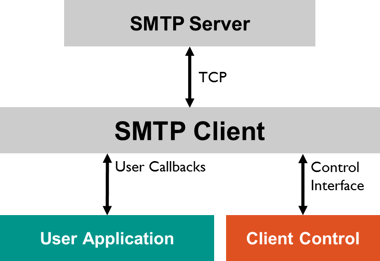An SMTP Client allows sending of e-mail notifications using a SMTP server. More...
Content | |
| Control Interface | |
| Functions to connect to an SMTP server. | |
| User Callbacks | |
| Functions to notify the user application about SMTP client events. | |
| File System Interface | |
| SMTP client functions that work with a File System. | |
| Configuration | |
| Configuration of the SMTP client. | |
| Enumerations | |
| Enumerations of the SMTP Client. | |
| Structures | |
| Structures of the SMTP Client. | |
An SMTP Client allows sending of e-mail notifications using a SMTP server.
Simple Mail Transfer Protocol (SMTP) is a widely used protocol for the delivery of e-mails between TCP/IP systems and users.
The SMTP Client can send e-mails to various recipients. A typical use case is to send automated e-mail notifications to different e-mail addresses. To send e-mails, the SMTP Client needs to connect to an SMTP server that will send the messages to the targeted recipients. Nowadays, SMTP servers usually require a client authentication using credentials. The SMTP Client can send these credentials to get access to the server. In the current version, the SMTP Client supports LOGIN, PLAIN and CRAM-MD5 atuthentication methods.
E-mails may contain a static predefined message or a dynamic message. An example of dynamic e-mail content is to include measurement results from a log file or from a current measurement.

This documentation is separated as follows: